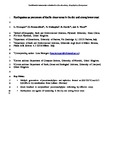Earthquakes as Precursors of Ductile Shear Zones in the Dry and Strong Lower Crust
| dc.contributor.author | Menegon, L | en |
| dc.contributor.author | Pennacchioni, G | en |
| dc.contributor.author | Malaspina, N | en |
| dc.contributor.author | Harris, K | en |
| dc.contributor.author | Wood, E | en |
| dc.date.accessioned | 2017-12-18T14:20:31Z | |
| dc.date.available | 2017-12-18T14:20:31Z | |
| dc.date.issued | 2017-12 | en |
| dc.identifier.issn | 1525-2027 | en |
| dc.identifier.uri | http://hdl.handle.net/10026.1/10440 | |
| dc.description.abstract |
The rheology and the conditions for viscous flow of the dry granulite facies lower crust are still poorly understood. Viscous shearing in the dry and strong lower crust commonly localizes in pseudotachylyte veins, but the deformation mechanisms responsible for the weakening and viscous shear localization in pseudotachylytes are yet to be explored. We investigated examples of pristine and mylonitized pseudotachylytes in anorthosites from Nusfjord (Lofoten, Norway). Mutual overprinting relationships indicate that pristine and mylonitized pseudotachylytes are coeval and resulted from the cyclical interplay between brittle and viscous deformation. The stable mineral assemblage in the mylonitized pseudotachylytes consists of plagioclase, amphibole, clinopyroxene, quartz, biotite, ± garnet ± K-feldspar. Amphibole-plagioclase geothermobarometry and thermodynamic modeling indicate that pristine and mylonitized pseudotachylytes formed at 650–750°C and 0.7–0.8 GPa. Thermodynamic modeling indicates that a limited amount of H2O infiltration (0.20–0.40 wt. %) was necessary to stabilize the mineral assemblage in the mylonite. Diffusion creep is identified as the main deformation mechanisms in the mylonitized pseudotachylytes based on the lack of crystallographic preferred orientation in plagioclase, the high degree of phase mixing, and the synkinematic nucleation of amphiboles in dilatant sites. Extrapolation of flow laws to natural conditions indicates that mylonitized pseudotachylytes are up to 3 orders of magnitude weaker than anorthosites deforming by dislocation creep, thus highlighting the fundamental role of lower crustal earthquakes as agents of weakening in strong granulites. | |
| dc.language.iso | en | en |
| dc.publisher | American Geophysical Union | en |
| dc.title | Earthquakes as Precursors of Ductile Shear Zones in the Dry and Strong Lower Crust | en |
| dc.type | Journal Article | |
| plymouth.journal | Geochemistry, Geophysics, Geosystems | en |
| dc.identifier.doi | 10.1002/2017GC007189 | en |
| plymouth.organisational-group | /Plymouth | |
| plymouth.organisational-group | /Plymouth/Faculty of Science and Engineering | |
| plymouth.organisational-group | /Plymouth/REF 2021 Researchers by UoA | |
| plymouth.organisational-group | /Plymouth/REF 2021 Researchers by UoA/UoA07 Earth Systems and Environmental Sciences | |
| dcterms.dateAccepted | 2017-11-03 | en |
| dc.rights.embargoperiod | Not known | en |
| rioxxterms.versionofrecord | 10.1002/2017GC007189 | en |
| rioxxterms.licenseref.uri | http://www.rioxx.net/licenses/all-rights-reserved | en |
| rioxxterms.licenseref.startdate | 2017-12 | en |
| rioxxterms.type | Journal Article/Review | en |


